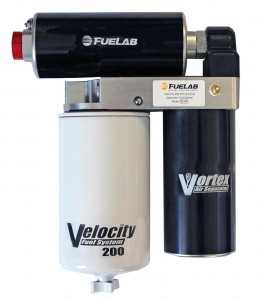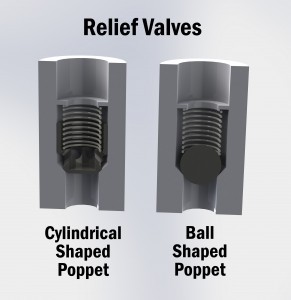Long-time diesel guys know the benefits of a lift pump.
By feeding the injection fuel pump with a steady supply of fuel, a properly operating lift pump assists in maintaining constant fuel pressure even under high loads. That means your engine has all the fuel it needs to make maximum power when you need it the most. In some cases, you can increase the amount of fuel pressure and flow to the engine by upgrading your lift pump. This often leads to power and performance gains.
However, even the most seasoned diesel guys have been known to misunderstand that relationship between diesel lift pump pressure and flow. This is a topic Matt Gilmore and our friends at FUELAB tackled in a recent article. As a leader in digital fuel delivery components for gasoline and diesel engines, FUELAB says one of the most common questions they get is: “Which is more important—pressure or flow?”
We’ll let Gilmore and the FUELAB team take it from here:

FUELAB’s Velocity 200 Inline High Performance Lift Pump also includes fuel filtration with water separation to ensure pure diesel fuel gets to the injector pump.
There seems to be a lot of confusion on this subject.
You must have adequate flow to support the needs of the engine. What about pressure? Is pressure just a product caused by the resistance to flow? Is pressure necessary? Does a drop in pressure at wide open throttle mean I don’t have enough flow?
Sizing a lift pump with adequate flow is the first step. You need enough flow to support the type of injection system you are running. Sizing by horsepower will get you in the ballpark, but ultimately your injection system has to be taken into consideration. Going off horsepower alone is not enough information.
Pressure exists due to a resistance in flow. When it is put that way, it sounds like a bad thing; however, pressure is necessary for a fuel system. Many fuel injection pumps rely on fuel pressure to operate the timing circuit. All fuel systems benefit from pressure during high demand situations. A diesel engine running at 3,000 rpm has very little time to fill a pumping element before the next cycle…milliseconds, literally. Pressure helps to fill the pumping element. If pressure drops too far, the pumping element will pull a vacuum. It will live with some vacuum, but too much will cause cavitation and vaporization. This condition can cause more damage than dirty fuel. In layman’s terms, cavitation causes the fuel to vaporize. The vapor fills the pump cavity; then the pump pressurizes the vapor. When the vapor is compressed, it implodes. The implosion erodes the metal away and leaves craters in the surface.
A quality fuel pressure gauge at the inlet of the injection pump should be used in all high performance applications. This is a cheap and simple way to monitor fuel system needs.
What causes pressure drop at WOT? The first thing that usually comes to mind is the lift pump won’t keep up.
That, however, is usually the incorrect answer.
Many things can cause low pressure. The fuel pressure relief valve (what regulates the pressure) is one that is often overlooked. Not all relief valves are the same. Even if they look identical, there can be minor differences that have a major impact on valve performance. Spring selection is one common mistake with budget relief valves. There is no “one size fits all” in this category. You cannot take an 8 psi relief valve and simply shim the spring to 18 psi. It can be set to run at 18 psi, but it will be erratic and drop off in pressure, under wide open throttle. A quality relief valve will run steady pressure at idle and maintain that pressure at cruising speeds. A full throttle run should have a minimal amount of pressure drop.
 It should be noted that fuel pressure relief valve poppet design can have a major impact on fuel pressure and flow.The Ball Shaped Poppet is commonly used, however, this is a flawed design as the ball can vibrate (also known as “valve chatter”), which inhibits smooth fuel flow and creates fuel pressure spikes. A Cylindrical Shaped Poppet provides a superior design, as the diameter of the upper portion of the poppet is stabilized within the bore of the valve housing. The poppet smoothly slides open and closed along the bore. This combined with the inlet ports on the side of the poppet smooths fuel flow, and valve chatter is virtually eliminated. This reduces fuel pressure spikes and results in a much better fuel flow curve.
It should be noted that fuel pressure relief valve poppet design can have a major impact on fuel pressure and flow.The Ball Shaped Poppet is commonly used, however, this is a flawed design as the ball can vibrate (also known as “valve chatter”), which inhibits smooth fuel flow and creates fuel pressure spikes. A Cylindrical Shaped Poppet provides a superior design, as the diameter of the upper portion of the poppet is stabilized within the bore of the valve housing. The poppet smoothly slides open and closed along the bore. This combined with the inlet ports on the side of the poppet smooths fuel flow, and valve chatter is virtually eliminated. This reduces fuel pressure spikes and results in a much better fuel flow curve.
Pressure versus flow–they are both important.
While flow is a necessity, pressure with good regulation is vital to a quality fuel system.

OPPS ..I THINK I POSTED IN THE WRONG SPOT..I HAVE A 2008 FORD F550 BUCKET TRUCK WITH A 6.4 DIESEL . PEOPLE ARE TELLING ME TO PUT IN A LIFT PUMP FOR THE FUEL.SHE SEEMS TO BE RUNNING FINE . ITS A HEAVY TRUCK . I’M NOT LOOKING TO DO WHEELIES WITH IT ..WHAT DO YOU THINK ?
[…] Posted inUncategorized Trucks, mostly applied for substantial bodily burden our vehicles which endure the maximum tights, tear and wear is just a normally occurring phenomena due to their heavy duty possessions, The consequences which aren’t too unpredictable, the very first working components to possess changed adversely could be the fuel injection mechanics. Thus, to eradicate this issue, apompe de relevageis what some other truck owner would desire so as to present an extra aid to the process of fuel-injection. Apart from this, the elevator pump additionally contains many other benefits to supply you with. Deciding on the right lift pump on your vehicle is a exact crucial measure for why it’s all the capability in hand to effectively Luxurious the survive duration Additionally your method of transfer from a good number of years.Several of the features One Needs to hold for some time Picking the Most Appropriate lift pump would be:-• It must really be as durable as it gets• The mechanism of the installation should not be hard, it ought to really be as hassle free as possible• The sound generated needs to be low as you can • Demands the least amount of care for upkeep functions • Lowers the maintenance Level of the engine of their automobile to• Delivers problems associated with injector pumps into an all-time reduced • R E acquires lost millage if There Is One Its gains include things like providing a growing economically the millage along with a greater quantity of features associated with your good. Mostlythe elevator pump is suggested for vehicles who have found a lot of automobiles and yours that are bought at a second hand. To choose the apt elevate pump, can be a fantastic task by it self, As unique kinds of elevator pumps operate variably for vehicles that are different. The factors for this are based on lots of all details and prerequisites of motor vehicle would need.Reference hyperlinkshttps://www.drivingline.com/articles/aftermarket-diesel-lift-pumps-the-catalyst-for-making-horsepower/https://www.onallcylinders.com/2015/12/16/lift-pump-basics/http://www.trucktrend.com/how-to/expert-advice/1310-lift-pump-primer-basic-training/For more details make sure you click on this particular link pompe de relevage. […]